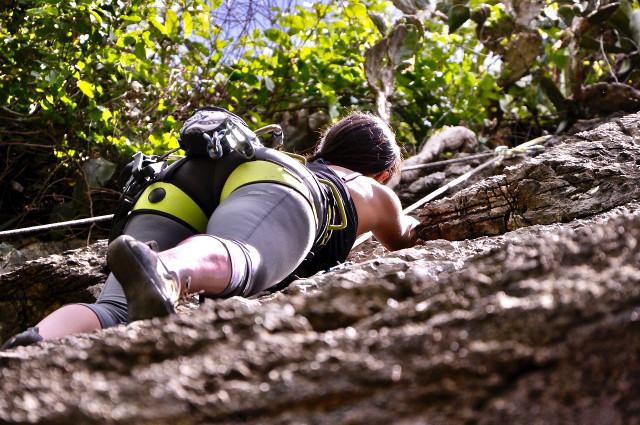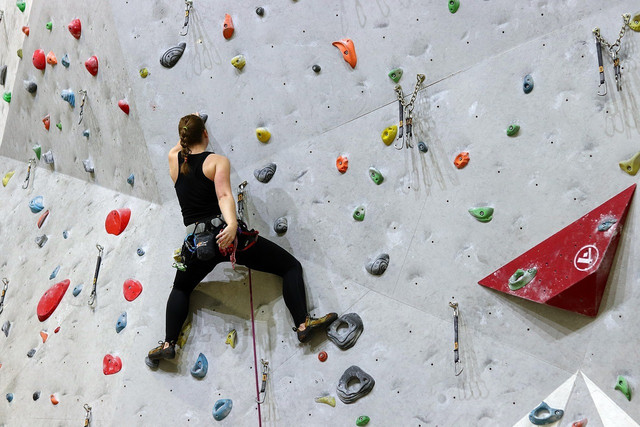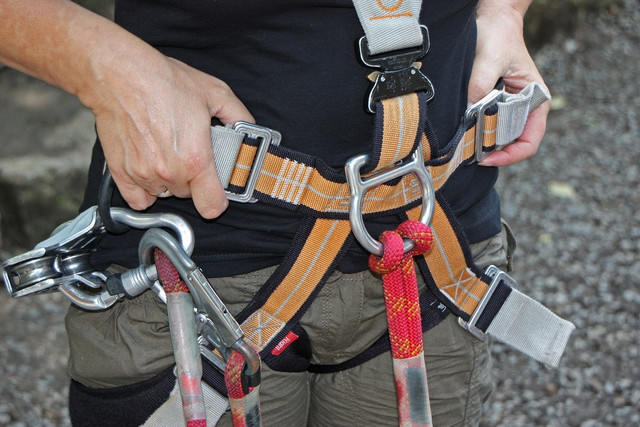If you are interested in climbing and you are going for the first time, choosing between rock climbing vs. bouldering is a difficult decision. Learn which is best for you.
Although rock climbing and bouldering are both very common forms of climbing, they are different in technique, tools, and challenges. So if you are interested in climbing but don’t know whether you’d prefer rock climbing or bouldering, there are some factors that could make the decision easier for you.
One of these factors includes whether you’d like to climb indoors or outdoors as weather and location can determine the climbing options. The following is an overview of the options available in different locations in the United States and a list of things to keep in mind when you decide on rock climbing vs. bouldering.
Rock Climbing: Indoors & Outdoors

(Foto: CC0 / Pixabay / erikamarcialm)
Rock climbing is the act of climbing up, down, or across natural rock formations, though this can be mimicked in an indoor setting as well. The goal is to reach a pre-determined endpoint following a specific route.
Indoors: There are countless numbers of indoor gyms throughout the US that offer top rope climbing even though they might be fewer than bouldering gyms. Here are some key features:
- In indoor gyms, climbers can improve their skills in a controlled environment. Each gym offers a choice of routes with varied degrees of difficulty. Therefore, climbing indoors guarantees a consistent experience all year long.
- Indoor gyms are not affected by weather and climbers, therefore one can easily measure their progress.
- Indoor climbing typically requires a climbing partner, as one person has to belay while the other climbs. However, some gyms offer auto-belay devices that make it possible to climb on your own.
Outdoors: Rock climbing outdoors is very different from climbing indoors. Here are the primary differences:
- Outdoor climbers need to bring their own ropes and safety gear. Also, natural rocks do not give you obvious or colored routes, so climbers have to be quite sure of their skills and climbing knowledge.
- Outdoor climbing is dependent on geographical location and only exists in specific locations in the US. Some states like California or Colorado provide many of these locations with famous areas like Yosemite National Park, Joshua Tree National Park, or Red River Gorge.
- Outdoor climbing is weather-dependent as intense rain, snow, or heat can make sites unsafe or inaccessible.
Bouldering: Indoors & Outdoors



(Foto: CC0 / Pixabay / nightowl)
Bouldering, on the other hand, is a form of free climbing performed on natural rock formations or artificial ones indoors. It’s done without the use of harnesses or ropes.
Indoors: Bouldering does not require very high walls, so there are more bouldering gyms than top roping gyms in general. Here are some key characteristics of indoor bouldering:
- Bouldering can be done completely on your own and you do not need a partner to go bouldering, even though a partner can still help you regarding safety.
- Indoor bouldering gyms offer padded floors and walls with a countless number of grips and routes.
- Climbers can train in a safe environment regardless of weather conditions.
- Bouldering still requires learning proper techniques, especially as falling can be quite dangerous if not done with the right technique.
Outdoors: Bouldering comes from the word “boulder” which describes a smaller rock formation outdoors. Natural environments such as forests, canyons, or mountains provide these rock formations and there are a high number of bouldering locations throughout the US, and some are even in or close to big cities.
This makes it much easier to go bouldering than to go rock climbing outdoors. The most famous bouldering locations in the US are:
- Bishop
- Hueco Tanks
- Joe’s Valley
Outdoor bouldering is weather-dependent and can be impacted by rain, snow or cold temperatures. Most important of all, outdoor bouldering requires bringing a crash pad to fall on when climbing. Falling onto the relatively small crash pad can be quite dangerous, so it should only be done by experienced climbers.
Rock Climbing vs. Bouldering — Which One Is Easier to Learn? Which One Is Safer?



(Foto: CC0 / Pixabay / 7163893)
When comparing rock climbing vs. bouldering, it’s difficult to say that one is easier than the other. Nevertheless, rock climbing and bouldering are challenging in different ways. Here are some of the challenges that can help you decide:
1. Height: Even though rock climbing and bouldering both challenge people that are afraid of heights anyway, rock climbing walls are much higher. Rock climbing involves learning how to belay, how to make several climbing knots, and how to manage the rope. In many gyms, you have to pass a test first before you are allowed to climb with a partner.
2. Difficulty: Bouldering concentrates on shorter routes called “problems” and does not require a rope. Some gyms still make you take a quick introduction to how to fall correctly, but most of the time, you do not need to pass a test to start bouldering. As bouldering routes are shorter, though, problems can be difficult to climb right from the beginning, which can make the experience more frustrating.
3. Safety: When rock climbing, you have to trust your partner 100%, as they literally have your life in their hands. If your partner knows how to belay correctly, rock climbing is very safe. Bouldering, on the other side, requires trust in yourself. When falling, you have to keep control and fall safely so you don’t hurt yourself. The risk of straining an ankle or worse injuries is higher.
4. Gear: Bouldering typically has lower costs regarding gear, as you only need shoes and chalk (and a crash pad for outdoor bouldering). For rock climbing, you need to have a harness and a belay device as well. If you want to go rock climbing outside, you also need ropes, carabiners, and other safety gear. Luckily, indoor gyms often offer shoes, chalk, and harness to rent, so you do not have to buy gear before you try it for the first time.
5. Costs: Bouldering can be easier for beginners, as there are many indoor bouldering gyms, and memberships of bouldering gyms tend to be cheaper than the ones of full-service climbing gyms. Moreover, outdoor bouldering locations are often easier to access and can be found in a range of locations such as forests, city parks, and recreation areas.
6. Community: Whether it’s rock climbing or bouldering, climbing is a great way to meet people and make new friends. Different from regular gyms, climbing gyms are very social and people interact with each other frequently.
Rock Climbing vs. Bouldering: Final Thoughts



(Foto: CC0 / Pixabay / DorianKrauss)
In conclusion, rock climbing and bouldering might seem similar in many ways but still show a lot of differences regarding difficulty, safety, costs, and community. People tend to enjoy both forms of climbing, and people that go bouldering or rock climbing indoors will also aspire to do so outdoors at some point.
If you go climbing for the first time or want to start going climbing regularly, it is great to know all the factors of rock climbing vs. bouldering and pick what suits your interest best.
Utopia’s Tip: Climbing communities are very friendly and people like to help each other with climbing problems or even finding climbing partners. If you start going to the same gym regularly, you might find that people will approach you or even want to climb the same routes with you together.
Read more:
- 9 Yoga Alternatives for Mindful Exercise
- 12 Reusable, Eco-Friendly Water Bottles for Sports and Everyday Hydration
- Boost Your Immune System: 10 Ways to Improve Your Natural Defense System
Do you like this post?









